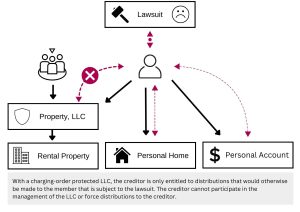- A charging order allows an LLC member’s creditor to seize distributions to that member.
- Charging-order protection limits the creditor’s reach and protect the other LLC members.
- Single-member LLCs do not have other members to protect and are unlikely to enjoy charging-order protection.
- The operating agreement can include provisions to further protect members from outside liability.

Charging-Order Protection
A charging order is a judicial remedy that allows creditors of an LLC owner (member) to seize any distributions that would be made to that member.
To obtain a charging order, a creditor must obtain a successful judgment against a member (debtor-member). After the court issues the judgment, the creditor can petition the court to issue a charging order. When the court issues a charging order, the LLC must pay the creditor any funds that would otherwise be distributed to the debtor-member of the LLC.
Viewed in isolation, a charging order seems like a bad thing. No one wants a creditor to have any rights to LLC profits or distributions. But charging orders are actually much better than the alternative.
A creditor’s goal is to collect on the debt. Given the ability to do so, a creditor would seize the debtor-member’s interest in the LLC and do everything it could—including liquidating the LLC—to compel a distribution to satisfy the debt. Allowing a debtor-member’s creditor to participate in management of the LLC would be unfair to other members of the LLC that were not involved in the debtor-member’s lawsuit.
Charging orders protect the other LLC members from being forced into partnership with a debtor-member’s creditor. Because of this protective effect, LLCs are often said to be charging-order protected.
In many states, a charging order is the creditor’s exclusive remedy. For example, the Texas Business Organizations Code provides:
The entry of a charging order is the exclusive remedy by which a judgment creditor of a member or of any other owner of a membership interest may satisfy a judgment out of the judgment debtor’s membership interest.1
This means that the creditor is limited to any distributions that would otherwise be made to the debtor-member. The creditor may not seize the debtor-member’s interest in the LLC or participate in the management and operations of the LLC.2
Comparison of LLCs with Other Forms of Business
Most businesses are formed to limit the liability of the owners. The first corporations formed in the 17th century were chartered to protect the shareholders from personal liability for business debts and obligations. Without this so-called corporate shield, the shareholders would be legally responsible for corporation’s debts and legal obligations.
Even though both corporations and LLCs protect the owners from liability for the business debts and obligations (inside liability), corporations do not protect the innocent owners for debts of a shareholder involved in a lawsuit (outside liability). A shareholder’s creditor may seize the shareholder’s stock and participate in the business’s management to the same extent that the shareholder could participate before the judgment. This makes an LLC a better choice than a corporation for most businesses.
Like LLCs, partnerships—including general partnerships, limited partnerships (LPs), limited liability partnerships (LLPs), and limited liability limited partnerships (LLLPs)—are also charging-order protected. In most cases, though, partnerships come with downsides that LLC’s do not. And because almost any business that could be structured as a partnership can also be structured as an LLC, there is little reason for most businesses to consider partnerships.
Charging Orders and Single-Member LLCs
As stated above, charging-order protection is designed to protect the other members of the LLC from being forced into partnership with a debtor-member’s creditor that may want to liquidate the LLC to satisfy a debt. This rationale assumes that there are other owners to protect. When an LLC is owned by a single member, the rationale for charging-order protection breaks down. With a single-member LLC, there is no “innocent” owner that would be unfairly penalized by the creditor’s seizure of the LLC assets.
When state legislatures first began to authorize LLCs, they borrowed the charging-order provisions from partnership law. Partnership law was not designed to provide charging-order protection to a one-owner business for the simple reason that a one-owner business is not a partnership. By definition, a partnership involves more than one partner. In recognition of this, some state legislatures have passed laws to limit charging-order protection to multi-member LLCs.

Attorney Practice Note: Federal bankruptcy courts disfavor extending charging-order protection to single-member LLCs. Beginning with In re Albright, 291 B.R. 538 (Bank. D. Colo. 2003) and In re Ehmann, 319 B.R. 200 (Bankr. D. Ariz. 2005), federal bankruptcy courts have refused to extend charging-order protection to single-member LLCs that file for bankruptcy. These cases allowed the creditor to succeed to the management rights of the debtor-member. This arrangement allows the creditor (through the bankruptcy trustee) to force the LLC to liquidate and distribute funds to the creditor to satisfy the judgment.
Single-member LLCs are still useful tools for business owners. They are particularly useful in the holding company model, where they can confine the liabilities associated with a particular asset to the asset. This protection against inside liability does not depend on whether the LLC is single- or multiple-member. But if the member of a single-member LLC wants to take advantage of charging-order protection, the member should consider adding an additional member to the LLC.
Adding an additional member need not be complex and can often be accomplished with no adverse tax consequences. For example, a member’s living trust or another single-member LLC could be added as a second member. These entities are both disregarded for federal tax purposes, allowing the income from the LLC to be reported on Schedule C of the member’s personal return without additional tax complexity. If property documented, the addition of a second member, even with a relatively small interest, can provide charging-order protection.
Enhancing Charging-Order Protection
Although charging-order protection effectively prevents creditors from interfering in the LLC’s management, a few additional strategies can be used to create additional layers of protection:
- Transferability Restrictions. Transferability restrictions limit the members’ ability to transfer their LLC interest. Depending on the goals of the members, transferability restrictions may be drafted to permit certain transfers—like transfers to spouses or children—while requiring consent for others. By requiring consent of all members to admit a new member, transferability restrictions make it more difficult for a creditor to claim that the creditor is now a member of the LLC.
- Manager-Managed Structure. LLCs may be member-managed or manager-managed. Using a manager-managed LLC provides an additional layer of protection by separating the LLC management from the economic consequences of ownership. Even if a creditor can seize a member’s membership interest, that interest only entitles the creditor to the economic rights of the member. The management rights are separate, allowing the LLC management to remain with the managers as specified in the operating agreement.
As always, a properly drafted operating agreement is essential for ensuring that the LLC protects the members.